 From the Wall Street Journal: "On a quiet Park Slope block, the rarest of buildings has taken shape — a brand new brownstone. A lot measuring 16 feet by 100 feet was big enough for just one house, and that's what developer Seth Brown and landowners Herb and Gayle Solomon have built — a home with four stories for a single family, an additional garden apartment, and a brownstone-colored facade. Charles Lockwood, author of "Bricks and Brownstone: The New York Townhouse 1783-1929," says that when the Park Slope area first took shape in 1860, the houses weren't usually built one at a time. 'Houses were put up by builders in groups, just like the suburbs,' Mr. Lockwood says. Modern engineering allowed some changes from a typical brownstone layout. For example, there's no load-bearing wall splitting the front parlor from the interior stairs. Features inside include a bathroom on each floor and tall front windows." Full article here. (Photo credit Natalie Keyssar.)
Astute readers will note that above it says "brownstone-colored", not actual brownstone. The New York Post reports on a proposed one-up: "For the first time in decades, if not a century, a townhouse made from actual brownstone quarried from its original source is being built in the borough that made the architectural style famous. Designer Tom van den Bout said his retro-chic townhouse would use stone sourced from Portland Brownstone Quarries in Connecticut. The new house on a long-vacant lot will likely get the necessary approval of the Landmarks Preservation Commission. After all, Van den Bout consulted neighbors to tweak the finished design and the Brooklyn Heights Association supports the plan. 'It’s an appropriate thing if you’re building a new building in a neighborhood dominated by brownstones,' said architectural historian Francis Morrone. Brownstone was a fad in the latter half of the 19th century, not only because architects in the Victorian age liked earth tones, but because it was cheap. As the city and its middle class grew, people started living further from work and developers built up Brooklyn as a suburban spot. Like the last housing bubble, homes began to get bigger, more pretentious — and more shoddily built. 'These were like the first McMansions and this was the first urban sprawl,' said Morrone." Full article here.
From the Wall Street Journal: "On a quiet Park Slope block, the rarest of buildings has taken shape — a brand new brownstone. A lot measuring 16 feet by 100 feet was big enough for just one house, and that's what developer Seth Brown and landowners Herb and Gayle Solomon have built — a home with four stories for a single family, an additional garden apartment, and a brownstone-colored facade. Charles Lockwood, author of "Bricks and Brownstone: The New York Townhouse 1783-1929," says that when the Park Slope area first took shape in 1860, the houses weren't usually built one at a time. 'Houses were put up by builders in groups, just like the suburbs,' Mr. Lockwood says. Modern engineering allowed some changes from a typical brownstone layout. For example, there's no load-bearing wall splitting the front parlor from the interior stairs. Features inside include a bathroom on each floor and tall front windows." Full article here. (Photo credit Natalie Keyssar.)
Astute readers will note that above it says "brownstone-colored", not actual brownstone. The New York Post reports on a proposed one-up: "For the first time in decades, if not a century, a townhouse made from actual brownstone quarried from its original source is being built in the borough that made the architectural style famous. Designer Tom van den Bout said his retro-chic townhouse would use stone sourced from Portland Brownstone Quarries in Connecticut. The new house on a long-vacant lot will likely get the necessary approval of the Landmarks Preservation Commission. After all, Van den Bout consulted neighbors to tweak the finished design and the Brooklyn Heights Association supports the plan. 'It’s an appropriate thing if you’re building a new building in a neighborhood dominated by brownstones,' said architectural historian Francis Morrone. Brownstone was a fad in the latter half of the 19th century, not only because architects in the Victorian age liked earth tones, but because it was cheap. As the city and its middle class grew, people started living further from work and developers built up Brooklyn as a suburban spot. Like the last housing bubble, homes began to get bigger, more pretentious — and more shoddily built. 'These were like the first McMansions and this was the first urban sprawl,' said Morrone." Full article here.
